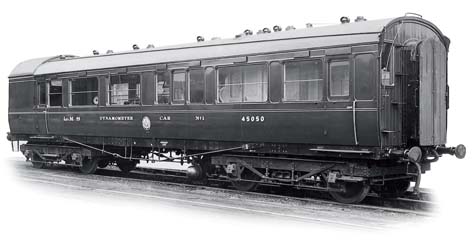

Working Life
Restoration
Preservation
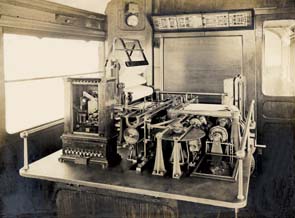
The recording table of dynamometer car No. 293 as built
showing the circular integrator on the right and the
clockwork timing clock on the left. Beyond is the moving
paper roll, fed from a reel on the left and taken up on the lower right,
upon which the various ink pens make traces showing
deflection of the drawbar springs, time and distance
travelled and other events such as water and coal
consumption are marked. (Lancashire & Yorkshire Railway Official)
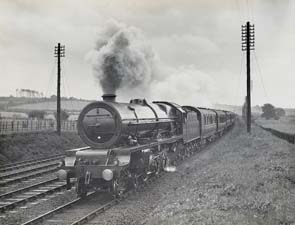
As yet without smokebox door number plate,
Stanier 4-6-2No. 6200 ‘The Princess Royal’, with
dynamometer Car No.1 behind the tender, at speed on
the ‘Special Limit’ timings testrun of 15 th August 1933
between London Euston and Crewe. (J.B. Radford Collection)
This dynamometer car was built by Lancashire & Yorkshire Railway in 1912 to the requirements of George Hughes, C.B.E., the company’s Chief Mechanical Engineer, and ran its first trials on 7th February 1913 testing the performance of the first of Hughes 4-6-0 four cylinder express passenger locomotives No.1506.
The dynamometer car is attached behind the locomotive and is used to measure its performance by means of a drawbar attached to a nest of horizontally placed springs beneath the floor which deflect under load. An arm connected to the springs comes up through the floor and transmits the deflection up to the recording table, allowing it to be used to calculate the horsepower generated by means of a mechanical integrator mounted on the table. The output is then automatically recorded by means of one of several pens making traces on a moving roll of paper drawn under them at a known rate.
An independent road wheel with a diameter of 33.613 inches is located between the bogie wheels near to the observation or ‘balloon’ end of the car. This can be lowered by a screw onto the track and used to drive, by means of bevel gears and shafting, all of the elements of the instrument table which depend on the running speed and recording distance travelled.
Other information is also recorded such as water and coal consumption which are marked on the dynamometer car roll during the tests. By means of visual observations by engineers seated high up in the ‘balloon’ end of the car, which is always next to the tender, each shovel-full of coal delivered into the firebox can be noted, whilst the consumption of water is measured by a pre-calibrated ‘U’ tube gauge. With no telephone communication with the footplate staff, events are recorded by using a bell push and a system of bell codes and marked as ‘events’ on the moving roll of paper.
Taken over by the L.M.S. in 1923, this historic vehicle was used to test such locomotives as Fowler’s ‘Royal Scot’ class 4-6-0’s, Stanier’s ‘Princess Royal’ and ‘Princess Coronation’ class 4-6-2’s, and took part in the 1948 Locomotive Exchange Trials to evaluate various locomotive types used by the four main companies, resulting in the design and building of the British Railways Standard range of steam locomotives, which it was also subsequently used to test.
In 1948 it was also used to test the first main line diesel electric locomotives used on Britain’s railways, Nos 10000 and 10001, and also later generations of diesel motive power. It was withdrawn in 1967 and fortunately saved for preservation.
Built at the Newton Heath Carriage Works of the Lancashire & Yorkshire Railway in 1911 the vehicle moved to the company’s nearby Horwich Locomotive Works for final fitting out. It was painted in the company’s livery and numbered 293, and ran its first trials on 7 th February, 1913 testing the performance of the Hughes four cylinder 4-6-0 express passenger locomotive No.1506.
With the arrival in 1932 of William Stanier, the car was used to test his new locomotives, including the large and powerful 4-6-2 ‘Pacific’ types built from 1933 onwards. The dynamometer car, now renumbered 45050 and designated ‘L.M.S. Dynamometer Car No. 1,’ was used to record the performance of Stanier 4-6-2 No. 6200 ‘The Princess Royal’ on the ‘Special Limit’ timings test run on 15 th August, 1933, and also the special run of No. 6201 ‘Princess Elizabeth’ when she ran non-stop between London and Glasgow, a distance of 401 miles on 16 th November, 1936, also returning non-stop the following day. The findings enabled further developments to take place and the ‘Princess Coronation’ class of streamlined 4-6-2’s to be developed – the most powerful type of express passenger locomotives ever to run in the British Isles.
It was subsequently used to extensively test the new types of B.R. Standard steam locomotives built as a result of these trials, as shown on the photographs taken during trials with 4-6-2 No. 70000, yet to be named ‘Britannia’. And when the new generation of diesel electric locomotives came along from 1960 onwards, the dynamometer car continued in use carrying out performance tests on those.
45050 was last used on riding tests with fly-ash wagons between Derby and South Wigston on 22nd August 1967, and was finally withdrawn in November 1970 and about to be cut up at the nearby scrap metal yard of Albert Looms at Spondon near Derby. However, Raymond Smith, a Testing and Performance Section Engineer and Brian Radford, a Senior Technical Officer from the C.M.E.’s Director of Design staff both thought that it deserved to be preserved as an historic vehicle. The latter wrote a letter asking that it be made available for future display in a proposed museum then being set up by Derby Museums. The request was passed to the then Chief Mechanical & Electrical Engineer. T.C.B. Miller who agreed to the proposal, following positive support from R.G. Jarvis, Mechanical Engineer Design (Derby) and members of the Testing & Performance Section.
After storage in the Derby the vehicle moved to the Midland Railway site at Butterley in September 1975 where it was re-painted in its original LMS maroon livery by S. Huson and members of the Project Group’s Carriage & Wagon Department, who also began some restoration work.
By 2002, being very conscious of the major historical importance of the vehicle and its relevance to the P.R.C.L.T’s ‘Acquisition & Collecting Policy’, an approach was made to the Midland Railway Trust for their formal agreement to 45050 being removed from their list of vehicles, since at that time it was nominally listed as being leased to them by Derby City Museums. After discussions, this was eventually achieved and the vehicle was moved into the P.R.C.L.T.’s West Shed on 15th January 2005, where it has since been on static display in its current state. March 2008 saw the award of a Heritage lottery Fund grant be awarded for 45050's restoration to its 1930's condition.
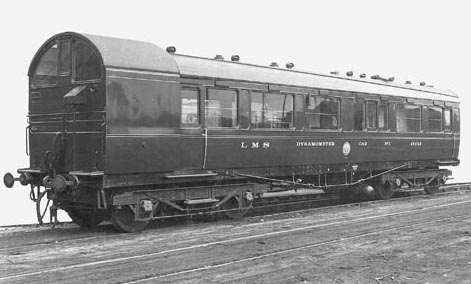
45050 in 1938. It is to this condition that the vehicle has been restored.
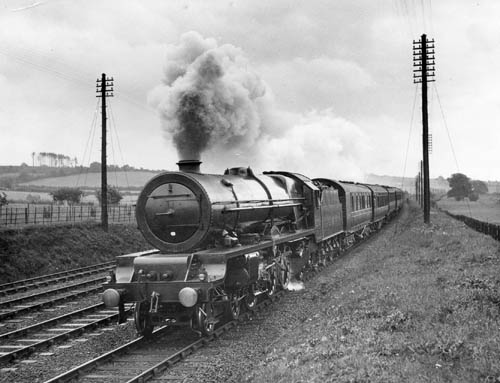
6200 'Princess Royal' on the first 'Special Limit' test run from Euston to Crewe 15th August 1933 with 45050 L&Y Dynamometer Car attached between the tender and train.
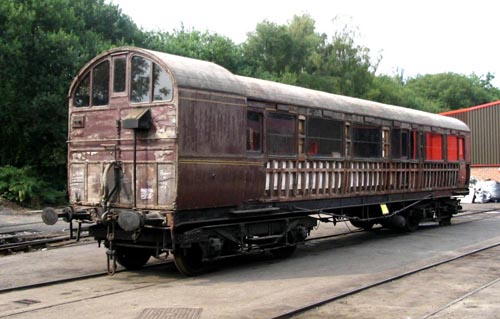
45050 stands outside West Shed 26th July, 2006 pictured in her condition prior to restoration.

At a meeting of the East Midlands Committee of the HLF, held on 4th March last chaired by Tony Hams, OBE, a Heritage Grant of £154,000 was secured towards a total project cost of £178,400. As part of the requisite Partnership Funding for the project, the Trust has already provisionally secured a grant in support of the special conservation costs of the vehicle and also a further grant from the Regional Museum Fund, administered by Renaissance East Midlands, for two internal video cameras to enable virtual access to the vehicle. The Trust itself is committed to contributing volunteer labour in support of the interpretational and educational aspects of the project and cash from existing funds as part of the overall project costs.
This unique and historically important vehicle, designed by the Lancashire & Yorkshire Railway’s Chief Mechanical Engineer George Hughes and built by the company in 1912, marked a highly significant scientific advance in its first use of a mechanical integrator to combine speed with drawbar pull/push to give units of work done. Early work on such cars began in 1818 with George Stephenson’s swinging pendulum wagon, continued with Charles Babbage’s first primitive dynamometer car of 1838-9, and those of D. Gooch (1846-7), F.W. Webb (1894), J.A.F. Aspinall (1896), G.J.Churchward (1901) and W. Worsdell’s N.E.R. copy of 1906. Amongst this distinguished company, the Hughes car stands out as the one directly linked to Babbage’s early work on mechanical computing. Ownership of the vehicle passed to the London, Midland & Scottish Railway Company at grouping, and enabled high standards of accuracy to be achieved in the 1930s during the high-speed testing of locomotives such as Sir William Stanier’s 4-6-2- express passenger engines, of which one of each type is in the Trust’s collection.
The completed 45050 is on static display in the Trust’s ‘West Shed Experience’ museum complete with four full-sized mannequin figures, one animatronically activated (like the existing figure of Sir William Stanier in the museums gallery dedicated to him), whilst two active video cameras are mounted in the roof, controlled from a ground level booth and with both zoom and rotational facilities, enable all visitor’s to obtain live ‘virtual access’ to the interior as they listen to a background soundscape mimicking testing actually in progress. A new film about the car’s fascinating history, including historic still photographs and film footage, has been further amplified by new footage shot during a special run on the adjacent Midland Railway – Butterley tracks with surviving members of the former Testing & Performance Section’s staff at Derby on board to simulate a test actually in progress.
Educational use of the vehicle:
Schools
The car is utilized by schools as a valuable educational tool, due to its scientific and engineering links. The dynamometer car and its related subject areas has direct links to the National Curriculum and plays an important role in the development of teaching resources and activities for visiting school groups.
Special Interest Groups
e.g. railway societies, specialist engineering groups
The scientific and technological importance of this vehicle is also widely recognized, as is evidenced by the number of letters of support for the project received from many outside bodies. In addition to forming part of the general ‘West Shed Experience’, the restored dynamometer car is of particular interest to members of groups with either a personal or professional interest in this vehicle and its history, including railway enthusiasts and todays railway testing engineers.
